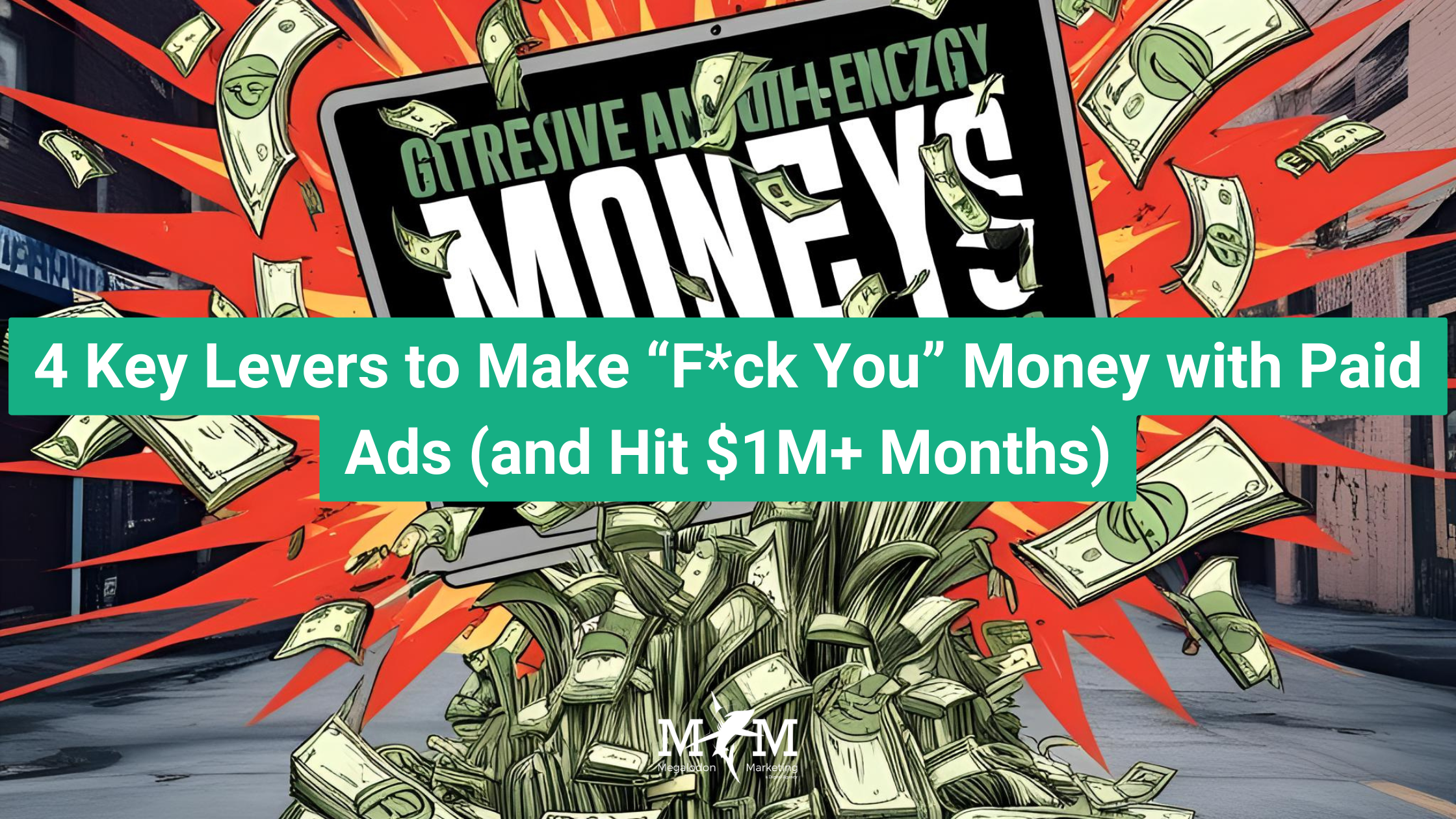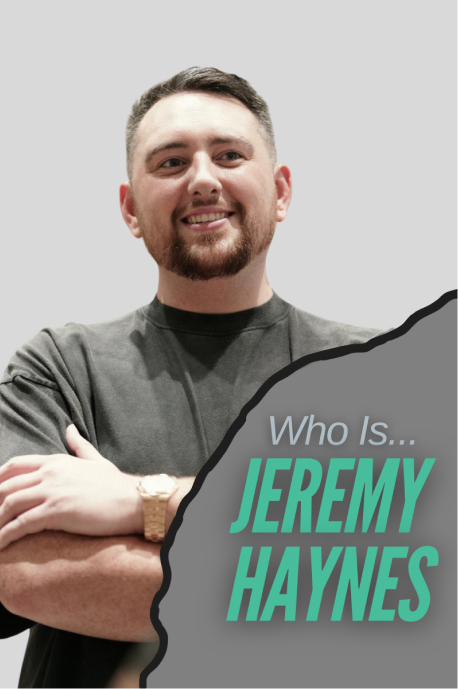I hope you enjoy reading this blog post. If you want my team to just do your marketing for you, click here.

I hope you enjoy reading this blog post. If you want my team to just do your marketing for you, click here.
Author: Jeremy Haynes | founder of Megalodon Marketing.

Earnings Disclaimer: You have a .1% probability of hitting million dollar months according to the US Bureau of Labor Statistics. As stated by law, we can not and do not make any guarantees about your own ability to get results or earn any money with our ideas, information, programs or strategies. We don’t know you and, besides, your results in life are up to you. We’re here to help by giving you our greatest strategies to move you forward, faster. However, nothing on this page or any of our websites or emails is a promise or guarantee of future earnings. Any financial numbers referenced here, or on any of our sites or emails, are simply estimates or projections or past results, and should not be considered exact, actual or as a promise of potential earnings – all numbers are illustrative only.
Watch the full video breakdown on this topic here.
Let’s paint the picture: you’re pouring money into ads, hoping to scale past a few hundred thousand a month, maybe even break seven figures a month, and you keep hitting that income ceiling. Your sales team complains that leads are too cold or “not ready.” Meanwhile, you look at your platform dashboards—Facebook, Google, YouTube, whichever—and you feel the sting of rising costs and inconsistent conversions.
This struggle is more common than you’d think. Scaling paid ads doesn’t come down to a random hack or duplicating ad sets a dozen times. No, there are four core levers you can pull that each determine whether you’ll blast past your revenue goals or continue to plateau:
In every instance where I’ve helped scale businesses to consistent million-dollar months (not just hitting it once, but repeatedly), I’ve typically had to turn a few of these levers—sometimes all of them—to break that self-imposed glass ceiling. If you neglect any one of these, you might get some revenue, but you will never experience the profound leaps in profit that come from a fully optimized process.
Remember, you can’t look at a single video from 2017 or some outdated step-by-step blueprint and expect to succeed in 2025’s fast-paced, algorithmic environment. You have to apply modern tactics, content marketing, machine learning best practices, a strong pitch, the right price structure, and the best players you can find to handle your leads.
Let’s break down each lever, so you can see which ones you need to pull right now to level up.
When we talk about an “ad strategy,” we’re talking about the entire approach you use to connect with your audience on any paid platform—Facebook, Instagram, TikTok, YouTube, Google, or otherwise. An ad strategy isn’t just about writing some snappy copy or picking a neat background for your creative. It’s about structuring your campaigns so the algorithm can serve you, while also warming up the prospect through content.
If you approach paid ads with a purely direct-response mindset (e.g., a single ad that leads straight to a booking page), you’ll get only the lowest-hanging fruit: the folks who are already in a position to buy. In many niches, that’s an impossibly thin slice of the market.
Look, direct response can work. You can get a certain amount of conversions going straight for the kill. But as soon as you try to scale, you’ll notice costs shoot up, your sales team starts complaining about “bad leads,” and your close rate goes down. Why? Because you’re ignoring the “nurture” side of your ad strategy.
Nurture is often something we rely on from an organic standpoint—like a lead might have seen your long-form YouTube content, your Instagram posts, a mini-training, or a series of personal stories before they ever opt in to talk to you. That’s how they get warmed up.
But when you’re paying for that first touch, you can’t assume these leads have had the luxury of binging your content for weeks. So you have to incorporate nurturing within your paid strategy. That means retargeting them not only with offers but also with real content—testimonials, short videos, in-depth explanations—so they enter the sales conversation as if they’ve been following you for months.
Here’s another thing: every major ad platform you use operates on a sophisticated machine learning model. People think duplicating ad sets ten times, changing the budgets by $5 increments, or messing with weird “hacks” is how to win. That might have worked in 2017, but these platforms have matured.
Facebook (now Meta) has something called the Performance 5 (originally the Power 5), and it centers on trusting the algorithm to find the best audiences, letting your campaigns run cleanly with minimal duplication, and focusing on creative variations that feed the machine enough data. If you try to outsmart these trillion-dollar-level companies with random duplication “strategies,” you will lose the consistency game.
You are not going to outsmart Mark Zuckerberg and his phalanx of highly-paid engineers by ignoring the platform’s recommended best practices. If they say to keep the campaign structure simple, if they say to give enough budget so the algorithm can learn, trust them. Don’t rely on old, outdated methods that produce inconsistent or inflated cost-per-result metrics.
If you’ve heard me talk about this concept before, you know it’s one of my favorite ways to replicate what’s typically done organically—but inside your paid retargeting. We call it the “Hammer Them” Campaign because that’s exactly what it does. The moment someone takes the action you want—like applying, filling out a form, booking a call, or joining a webinar—your ads “hammer” them with a barrage of content.
Often, that looks like:
That relentless supply of content in the days between the lead’s opt-in and their call or purchase does wonders for bridging the gap between “I saw an ad and impulsively clicked” to “I’ve been following this brand’s advice and success stories for weeks.” If your ads can shrink that timeline and build trust quickly, your sales team will talk to leads who are basically warmed-up fans instead of icy-cold strangers.
Think about the difference in your close rate if a prospect has consumed four or five killer pieces of your content before showing up to a call. Contrast that with the typical zero to minimal content approach. It’s night and day.
Remember, you don’t have to guess whether you need this or not—if your salespeople constantly whine about “low-quality paid leads,” it probably means you’re ignoring the nurturing piece that your organic leads get automatically.
Once you start optimizing your ad strategy, you might see an initial lift. But if you still can’t crack the code, it could be because you’re using the wrong conversion mechanism. A lot of people get stuck trying to force a weekly webinar or direct call funnel even though it’s not appropriate for their price point or sales style.
The real question is, How are you initiating the close? Is it a phone call? A direct checkout page? A DM conversation? A weekly webinar that you pitch from, or a monthly webinar with a phone call as the next step? Each approach suits different products, price points, and audiences.
Picture a sales team that only closes the warmest leads. They’ve feasted on easy, organic “layup” deals for a year or more. Then, as soon as you present them with paid-ad leads who have maybe watched a single webinar or filled out one form, they fumble. They say, “These leads suck,” and your revenue stays flat.
That’s a sign that the mechanism itself might be too cold for these closers. Either you train your closers to handle cooler leads, or you implement a more robust conversion path (like a deeper content funnel or a different style of webinar). Sometimes you do both.
Some companies kill it on weekly or monthly webinars because their closers can handle post-webinar calls. Others flourish with direct-to-checkout funnels if the price point is low enough or the brand is strong enough. Others find that a DM funnel can be a gold mine if their audience is used to quick back-and-forth messaging. Your choice of mechanism has to align with your brand, your product, and your salespeople’s capabilities.
The frequency of your webinar can drastically change your results. I’ve seen entrepreneurs who, for years, ran the same weekly webinar, selling the same $3,500 product directly on the webinar, netting anywhere from $10k to $50k in a decent run. But eventually, it got stale. Show rates dipped, their net revenue dipped, and the frustrations soared.
In one of these cases, we scrapped the weekly format and shifted to a monthly big event. And instead of pitching a $3,500 low-ticket product, we introduced a $15,000 offer sold via phone calls that took place immediately after that monthly webinar. We also added a $10,000 “downsell” if the $15k was out of reach for some folks. The $3,500 product didn’t even factor into the new event.
Immediately, they went from netting $10k to $50k on a weekly basis (which might total $40k to $200k in a month if you’re consistent) to a single monthly webinar that grossed $600,000. Their net was over $300k, in December, right in the thick of holiday competition.
Others thrive in the exact opposite scenario: twice-a-week webinars. I know one group that crushes it by targeting the West Coast in one session and the East Coast in another. Because their team can handle that frequency (and the show rates are balanced by time-zone targeting), they rake in serious monthly revenue.
So, if you’re stuck on autopilot with your existing conversion mechanism—like a webinar that’s stagnating—experiment with switching to monthly, or doubling your frequency, or trying a direct-to-call approach. You’d be amazed how a simple shift can explode your numbers.
One of the best snapshots of this lever is an entrepreneur who sold a $3,500 info product for a couple of years. She did weekly webinars, but her results were trending downward. By pivoting to a monthly webinar that offered a $15,000 program, she transformed her business literally in one holiday season.
Here’s the short version of her story:
The key insight: the old price point felt too small for the caliber of customer she wanted, and the weekly frequency wasn’t creating enough excitement or urgency. With the monthly approach, people treated it like a bigger event, more of a “can’t miss” situation, and the higher price signaled a higher caliber product—bringing in customers who were ready to invest more.
If you’re confident your ad strategy is modern and your conversion mechanism is well-structured, yet you’re still hitting a profit ceiling, it’s time to examine the offer and pricing. Sometimes the best move you can make is to increase the price to reflect the true value of what you’re selling. Or, in other cases, you might need to package a new offer altogether—a high-ticket version that your best buyers actually want.
The market’s perception of your pricing is a massive signal. Charge too little, and they assume you deliver low-quality results. Price too high relative to your brand status, and you’ll scare off your best prospects because they’ll think it’s an unjustified cost. You need to be at a place where your price and your delivery match the expectations you set.
Ever heard the distinction between “costly” and “expensive”? When something is costly, it might have a high price tag, but every dime is justified. The item or service meets—or exceeds—your expectations, so you walk away feeling like it was worth every penny.
When something is expensive, however, you’ve paid a high price for it, but it betrays you by failing to meet your expectations. The experience or product doesn’t match the premium you paid.
Many entrepreneurs undercharge, making their products appear cheap, or they overcharge without elevating their brand or quality, making their products feel expensive (in the worst sense). The sweet spot is being “costly” in the best way—where people pay a premium and they’re thrilled to do so because the outcomes are phenomenal and the brand perception is top-notch.
I once encountered a small, gorgeous white leather Alexander McQueen clutch with these cool brass knuckle handles. The design was striking—truly a conversation piece. But the bag was priced at around $2,000 to $3,000. For that level of craftsmanship, I actually felt it should cost more, because if Chanel released that same style, it might easily go for $10,000.
Why does it matter? Because the moment you see a bag priced beneath what you’d expect from a true upper-tier designer, you start to wonder if it’s genuinely high-quality. Meanwhile, Hermès sells their Kelly or Birkin bags for tens of thousands (and sometimes hundreds of thousands if you venture into exotic skins). Buyers queue up because Hermès has that reputation of being the apex brand. You’re paying for a piece that’s “costly” but not “expensive” in the sense that it betrays you.
For your business, consider whether you’ve priced yourself like Alexander McQueen when, in reality, you want the brand aura and the clientele that buys Hermès. If your brand is truly providing a Hermès-level experience but charging drastically less, you might lose the top echelon of clients who’d happily pay more for what you’re actually delivering.
On the flip side, if you’re just starting to build your name, you don’t want to throw out a random Rolls-Royce price point if your brand is still perceived like a lesser-known label. It’s all about making sure your market believes in the value behind the ticket.
Imagine a $300,000 Range Rover. It happens—they release a special edition or a custom model that can easily exceed that price. If you’re in the market for a car at that level, you might ask yourself: “Why wouldn’t I just buy a used Rolls-Royce Cullinan under warranty for the same price?” After all, Rolls-Royce outranks Range Rover on the luxury totem pole.
This is a perfect analogy for a brand that’s priced itself out of its natural league. Unless Range Rover invests heavily into upgrading their brand status to match Rolls-Royce, any $300k model is going to repel buyers who think, “I might as well get a Rolls.” That’s how you must think about your own product or service:
Find your rightful place and either elevate your brand to match your new desired pricing or keep your price where your market’s perception lies (and deliver so well that you can raise the price confidently later).
The final lever is people. You can have the best structure, the perfect funnel, and an excellent offer with dialed-in pricing, but if you hand that over to a mediocre team, they’ll underperform every single time.
Conversely, a top-level operator—whether that’s a marketing specialist, a consultant, or a sales closer—can skyrocket your results. This is especially important in marketing and sales. You’d be shocked how often a single hire changes everything.
I’ve seen it happen where a business organically does one or two million in a month, but their paid ads only produce a paltry extra $100k to $300k. The business owner concludes, “Paid ads just don’t work for us,” never realizing that their media buyer simply isn’t equipped to handle big budgets, advanced machine learning strategies, or comprehensive content marketing.
Then they swap out that mediocre buyer for an A-player—someone who actually knows how to structure campaigns in 2025—and the monthly ad revenue leaps to $700k, $1 million, $1.3 million, or even more. Suddenly, the same brand, same offer, and same audience do far better because the person running the ads is at an elite level.
It’s no different with sales teams. If you’ve got closers who can handle inbound layups but crumble under direct-response funnel leads, you’ll cap out quickly. I’ve worked with organizations where, from a marketing perspective, everything was dialed in—great campaigns, excellent cost-per-lead, huge retargeting pools—but the sales team was dropping the ball. They only wanted the “hot, sure-thing” leads.
In these scenarios, recommending a new sales manager or a different sales structure can generate swings of hundreds of thousands of dollars in 30 to 60 days. If you can’t train your current people, bring in top closers who live for cold and warm leads. You’ll see an immediate ROI because you’re no longer throwing away leads you worked so hard (and paid so much) to acquire.
People also includes consultants and advisors. Sometimes, your current team is decent, but they’re missing the roadmap. They may not know the precise moves to scale from $150k months to $1 million months—especially if they haven’t done it before in your niche.
I’ve personally stepped into businesses where the leadership was talented, the sales manager was capable, and the media buyer was above average, yet they were still stuck at a fraction of the potential. Because I’d already helped a direct competitor scale to $2 million a month, I knew exactly what levers to pull. Within months, the new client was crossing that same million-dollar threshold.
The difference? They brought in someone who had done it before. The intangible benefit of having a consultant or mentor who’s been to the promised land in your exact market can collapse timeframes. It eliminates the guesswork and constant trial-and-error. It’s more than just good advice—it’s proven strategy from real-world experience in the same vertical.
So, if you suspect that your core team is strong but simply lacks the “been there, done that” factor, consider bringing in outside counsel. You might save yourself half a year (or more) of incremental, low-yield testing.
Look at your current situation. If your paid ads are underperforming, or if you’re only barely profitable, you need to do a serious audit of which lever is failing you. It could be:
Sometimes, the fix is straightforward. You raise your offer price, add a monthly webinar, or hire a top-notch advertiser. Other times, you need to make multiple changes. You might need to tear down an entire approach and rebuild from scratch. That can feel daunting, but the upside is enormous—often the difference between netting $150k a month and suddenly pushing $1 million a month is as simple as re-engineering a conversion funnel, layering on content retargeting, and trusting a real A-player to steer the ship.
The question to ask yourself right now is: Which lever (or levers) do I need to address today? Don’t wait until you’ve burned another $50k or $100k on lackluster campaigns. Do the deep dive. See if your ad strategy is a jumbled mess. Check if your team is complaining about lead quality because you’re not doing proper nurturing. Examine your offer and pricing—does it scream “bargain bin,” or does it scream “Rolls-Royce-level service”? And finally, look at the people on your staff. Do they have the proven track record to take you where you want to go?
When you align all four levers and continuously optimize them as you scale, you’ll notice that making “f*ck you” money with paid ads isn’t just a fluke or a lucky month. It becomes a repeatable process where hitting a million-dollar month (or beyond) is simply the new normal. That’s the outcome you want—a system that keeps spitting out life-changing revenue month after month.
Ready to take the next step and ascend to consistent million-dollar months?
Ultimately, making “f*ck you” money isn’t about one hack or one killer funnel—it’s about methodically perfecting these four levers until every dollar you put into ads is multiplied on the way out. That’s the real magic of paid advertising done right.
So, which lever will you pull first?
Remember: fix the lever that’s most broken, and watch how quickly your results turn around. If your ad strategy sucks, start there. If your sales team or funnel is the problem, overhaul your conversion mechanism. If your pricing is out of sync or your offer is stale, fix it. And if you’ve tried everything but still can’t break through, it’s probably time to upgrade your people or bring in an expert who has been there, done that, and can shortcut your journey in ways you never imagined.
Now go out there, implement these levers properly, and get ready to collect those million-dollar months like clockwork. When you see those sales rolling in and you realize just how powerful this system can be, you’ll never go back to half-baked advertising strategies again. Remember, nobody’s going to hand you “f*ck you” money—you have to set the stage so it inevitably flows in your direction. These four levers are exactly how you get that done.

Jeremy Haynes is the founder of Megalodon Marketing. He is considered one of the top digital marketers and has the results to back it up. Jeremy has consistently demonstrated his expertise whether it be through his content advertising “propaganda” strategies that are originated by him, as well as his funnel and direct response marketing strategies. He’s trusted by the biggest names in the industries his agency works in and by over 4,000+ paid students that learn how to become better digital marketers and agency owners through his education products.

Jeremy Haynes is the founder of Megalodon Marketing. He is considered one of the top digital marketers and has the results to back it up. Jeremy has consistently demonstrated his expertise whether it be through his content advertising “propaganda” strategies that are originated by him, as well as his funnel and direct response marketing strategies. He’s trusted by the biggest names in the industries his agency works in and by over 4,000+ paid students that learn how to become better digital marketers and agency owners through his education products.
This site is not a part of the Facebook website or Facebook Inc.
This site is NOT /endorsed by Facebook in any way. FACEBOOK is a trademark of FACEBOOK, Inc.
We don’t believe in get-rich-quick programs or short cuts. We believe in hard work, adding value and serving others. And that’s what our programs and information we share are designed to help you do. As stated by law, we can not and do not make any guarantees about your own ability to get results or earn any money with our ideas, information, programs or strategies. We don’t know you and, besides, your results in life are up to you. Agreed? We’re here to help by giving you our greatest strategies to move you forward, faster. However, nothing on this page or any of our websites or emails is a promise or guarantee of future earnings. Any financial numbers referenced here, or on any of our sites or emails, are simply estimates or projections or past results, and should not be considered exact, actual or as a promise of potential earnings – all numbers are illustrative only.
Results may vary and testimonials are not claimed to represent typical results. All testimonials are real. These results are meant as a showcase of what the best, most motivated and driven clients have done and should not be taken as average or typical results.
You should perform your own due diligence and use your own best judgment prior to making any investment decision pertaining to your business. By virtue of visiting this site or interacting with any portion of this site, you agree that you’re fully responsible for the investments you make and any outcomes that may result.
Do you have questions? Please email [email protected]
Call or Text (305) 704-0094